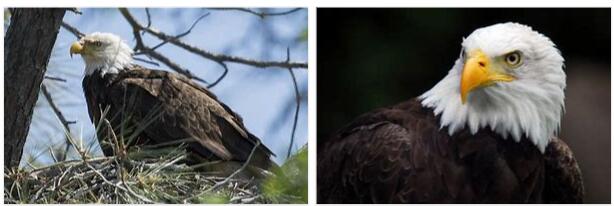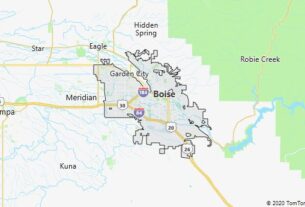The variety of climatic situations – in particular of precipitation – corresponds to that of plant formations, which naturally also depend on local, edaphic, altitudinal factors (the latter especially in the Rocky Mountains) etc.; in general we can recognize a vast central area with steppes and prairies, given the continental nature of the climate, and two beautiful forest strips, mainly broad-leaved trees in the Atlantic section of the country, conifers in the peaceful one. The temperate deciduous forest has its richest development in the Appalachian region, which associates various species (chestnut, oak, beech, maple), which in the higher and northern parts are associated with conifers of the genus Picea of the Canadian area and with birches. The fauna of the Appalachian region has local peculiarities and varieties common to the rest of the country. Among the mammals there are the brown bear, the American black bear (baribal), the grizzly bear (grizzly), the raccoon (raccoon), the coyote, the wolf, the fox, the possum, various mustelids such as the badger and the marten, rodents such as the flying squirrel, the marmot, the muskrat (ondatra). The waters of rivers, streams and lakes are rich in trout, muskellunge (a type of pike), walleye and whitefish, while cod, herring, mackerel, lobster, etc. abound on the North Atlantic coasts. The most common species of birds of prey, such as the ‘ eagle bald, national symbol, the gaviformi like the loonand fowl, such as wild turkey. In Piedmont, Florida and in the coastal strip of the Gulf with dark soils there is a subtropical forest dominated by various species of pines, such as the Longleaf pine (Pinus palustris), or pine with long needles, settled along the coast, where there are the characteristics cypress swamps, areas subject to flooding, in which water resistant plants such as some species of Taxodium, rubber trees (of the genus Nyssa) etc. are found. Typical of southern Florida are the marshy areas, derived from the difficult drainage of the peninsula, called the Everglades and formed by a tangle of different trees, often impenetrable, with mangroves, lianas, epiphytes. The coastal plains of the East are home to the Virginia deer, gray fox, lynx, gray wolf and various rodents, among others. In the Everglades there are reptiles, such as crocodiles, alligators and tortoises; land mammals, such as the Florida panther, wave, mink, otter, and marine mammals, such as the manatee and various dolphins; amphibians, insects, fish and birds, including herons, terns, frigates, peregrine falcons, woodpeckers, flamingos etc. United States is a country located in North America according to COMPUTERANNALS.COM.
The domain of the prairies, the grasslands, extends from the interior foothills of the Appalachians to the Rocky Mountains. AE of the Mississippi there is the so – called blue-grass, a prairie rich in grasses various, which becomes impoverished proceeding towards the W, especially between the foothills of the Rocciose and the Mississippi (in whose floodplains one finds the amphibious environment, of the aforementioned cypress swamps); among the xerophilous grasses of the steppe plains the buffalograss resembles the bovid. In the prairies where once the bison dominated and many other mammals lived, today there are few representatives of this class, in particular of the large carnivores, protected in the reserves and parks: in addition to bison there are coyotes, mountain lions (pumas), the bobcat, deer and wild horses introduced by the Spaniards, bighorn sheep and moose; rodents and moles are still widespread, as well as reptiles (snakes) and birds. The vegetation cover of the Rocky Mountain region is very varied: from the pastures of the higher altitude areas (with species common to those of the alpine meadows, such as gentian, saxifrage, etc.) to the underlying forests of larch, fir, pine, then to the xerophilous scrub, whose most characteristic tree species is the Pinus piñon (Pinus edulis), and gradually to the bushy steppe. Proceeding towards N and generally in sufficiently watered basins, the mesophytic forest appears, i.e. of medium humidity, with typical conifers such as fir douglas, yellow pine etc. The mountain forest of the Rocky Mountains and the surrounding area, where some of the major national parks are located, are home to mammals such as elk, bighorn sheep, antilocapra, grizzly and other bears, mountain lion, goat, wolf, coyote, wapiti, fox and bison, numerous birds such as eagles, herons, American cranes, swans, pelicans, various fish including several species of trout and grayling, as well as amphibians and reptiles. In the driest areas, such as the southern arc of the Rockies up to the border with Mexico, the chaparral stretches out, with thorny shrubs interspersed with succulent plants such as yuccas, agaves, cacti (the cereus, shaped like a candlestick, reaches even 15 m in height) etc. The fauna of the desert areas partly mirrors that of other areas of the country with large mammals (pumas, deer, bighorn sheep), coyotes and rodents (squirrel), birds (peregrine falcon, pelican, eagle) and is distinguished by the presence of various snakes. including the rattlesnake (rattlesnake green). The Mesophytic forest is found on the slopes of the Western Cordillera, but the vegetation takes on the most luxuriant aspects (humid forest) in the northern areas of the Cascade Range and the Coastal Range, and on the wetter slopes of the Sierra Nevada, where splendid coniferous forests appear, among which the gigantic sequoias emerge–Protected in a national park – even 100 m high.
In the southern Pacific, however, the arid environment reappears, which assumes mainly steppe aspects with grasses in the continental California Valley, while in the coastal strip with a Mediterranean climate there is again the chaparral, present here with bushy formations similar to those of the Mediterranean scrub. Mammals are again found between the mountain ranges and the Pacific coast, including skunks, elk, deer, etc.; birds of prey like the condor of California, seagull, guillemot, cormorant, pelican, falcon; amphibians, especially the salamander and fish such as salmon and herring. In the extreme North-West Alaska presents characteristics peculiar to the regions with an arctic climate, where the tundra is the dominant plant formation even if going towards the south-west there are coniferous forests with larch, silver fir, fir black in addition to birch and black poplar. Millions of salmon go up the rivers to the glaciers and are the typical species of this region even if there are numerous other sea and freshwater fish present, such as tuna, sardines, herring, cod, halibut, and marine and land mammals such as sea lion, sea otter, whale, seal, otter, bear, lynx, deer, elk and shrew; among the various birds, guillemot, swan and eagle. Palms, ferns, mangoes, hibiscus and orchids are the hallmark of Hawaii, volcanic islands characterized by sandy coral beaches. The local flora has been merging with that imported from the Pacific and the Americas; therefore there are pandani, Hawaiian mahogany while the native sandalwood has been lost due to the intense exploitation of the timber. The coral reef and tropical fish characterize the marine fauna while on the mainland there are birds and insects; mammals almost certainly appeared with the arrival of the colonizers.



